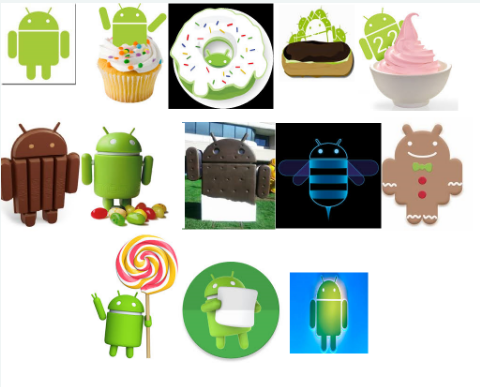Android-The most used mobile operating system has a great demand all over the world.With abundance of apps and vast amount of features, the Android OS is a great Demand as well as a need across the Globe.
Let's check out about the history and evolution of the world famous tablet and mobile OS.
History...
Android OS was developed by Android.INC and was later purchased by Google. The Android OS was developed by four people namely Andy Rubin, Rich Miner, Nick Sears and Chris White.The Android platform is based on Linux OS and features a numerous apps developed by Google and other third party developers.Smartphones running Android have a great sales rate worldwide.Android 1.0 (Astro)
The first Android was known as Android Astro which was developed by Android INC ,but later Android INC was purchased by Google for a whopping $50 million...!Android 1.5 (Cupcake)
Cupcake was Android's second major release and this time it was available commercially to the masses. Google fixed many bugs from the previous version and loaded it with plenty of good features. Widgets were introduced to Cupcake and third party developers could produce widgets for Android. Users could also upload videos and photos in apps like Youtube, Picasa, etc.Android 1.6 (Donut)
Android Donut consisted some major updates and the biggest update was the text-to-speech technology.Searches could be done by text as well as voice. It also supported searches for Bookmarks, Contacts, Music, Dictionary, etc. via voice.App screenshots were made available in this version of Android.The Gallery was fully integrated with Camera app for better viewing of photos taken from the Camera.Android 2.0 (Eclair)
Launced on October 26 2009, the Android Eclair was packed with some amazing features. There was Bluetooth 2.1 support for smartphones running Android 2.0. Multiple accounts for e-mail and contacts synchronization was made available. The browser had a new UI with HTML 5 support.The Camera app in this version if the Android had Flash support too!Android 2.2 (Froyo)
Android 2.2 had the support for creating Hotspots.It ran Adobe Flash 10.1 and also had Multilingual keyboard suport. Android users could also run Flash on their Android device and were treated to picture preview stacks in 3D photos.Android 2.3 (Gingerbread)
Android 2.3 had a revised interface for better User experience.Copy/Paste feature was also added to this version alongwith Integrated Internet calls. Users could switch between the the front and the rear Camera with the new and modified Camera app. In the last update of the GInger bread (.i.e. v2.3.7) Google introduced Google wallet which utilizes near field communication to store cards, redeem promotions, and even make secure payments from your Android device.Android 3 (Honeycomb)
Android 3 was specially designed for tablets whose interface was optimized for larger screens. It had improved multitaskng, notification management, etc. on the Home screen. This version had added tethering via Bluetooth and also built-in support for easy transfer of media files to the Computer or Laptop. The main view had two bars, first-Action bar for access to individual apps and widgets and second- The system bar showing notifications and soft-notification buttons.Android 4.0 (Ice Cream Sandwich)
Android 4.0 showcased a new font named Roboto (which is still in use in all Google Applications). It had support for WiFi Direct, Bluetooth HDP, and Android Beam. It also had the function of trigerring a photo with a smile. Default keys were docked at the bottom of the screen which were customizable and could carry multiple folders which were stacked together.Android 4.1 (Jellybean)
Android 4.1 was more faster, more smoother, and more responsive. Had Resizable widgets alongwith Google Now with Voice dictation feature offline. App updates were improved and made faster. And Notifications could be expanded with finger gestures to view full information.Android 4.4 (KitKat)
KitKat had support for Bluetooth MAP. Android 4.4 also had support for wireless printing as well as new Framework for transitions in the Interface. It also had optimization for memory and better touch for faster Multitasking.Android 5.0 (Lollipop)
Android 5.0 was launced on November 12 2014 alongside Nexus 6 and Nexus 9. The Android 5.0 was power packed with a brand new look, smarter Google Now, floating notifications, Built-in battery saverand most importantly NFC (easy data transfer to your smartphone with just Tag & Go.). Google introduced Material Design from Android 5.0 (which is still in use). Android smartclock was added to this version and ART was used instead of Dalvik Runtime.Android 6.0 (Marshmallow)
Android 6.0 a revolution in the battery life that the previous versions of the Android provided with. In short, this Android was Battery efficient. Fingerprint unlocking was made available in this version. Android 6.0 makes SD cards or external storages as encrypted expanded apps and games in the smartphones a whole lot easier.Android 7.0 (Nougat)
Android 7.0 is available across various languages. Another battery efficient OS from Android that can give you an all day long battery life. Android 7.0 brings you VR experience. VR experience available on Daydream ready smartphones.What to expect from Android 8...
Android 8 is expected to be Android Orange. As things are shifting to AI and Machine Learning from time-to time everyday.So we expect Android 8 to be a Bang. More insights to Android 8 will be Provided at our next article when Android 8 relases. Till then, Stay Tuned...!!!So this the History and evolution of the World famous Mobile and Tablet OS.

History of Android from Biotech.
Author: Chinmay Karmokar
Chinmay is a competeting & enthusiastic person. Striving to become a future entrepreneur,he eyes first success through Biotech.